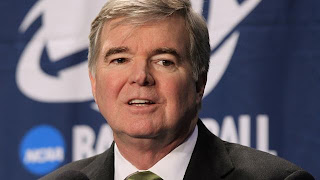NCAA President Mark Emmert is trying to generate momentum for significant changes in the NCAA. His “retreat” on August 9 and 10 with 50 college Presidents and Chancellors along with a few Commissioners, Athletic Directors and one faculty member represents a major gamble to test the appetite of the Presidents for serious change. If the Presidents align, the NCAA can launch a serious reform agenda.
Changing a large institution is not easy. With 1400 members and three levels of voting and a byzantine process of legislation, NCAA change initiatives face death by a thousand cuts and interest group vetoes. Glacial passes for supersonic at the organization.
To understand Emmert’s strategy and gamble, we need to realize that significant organizational change usually requires a confluence of conditions.
1) An institution needs a leader who is willing to take big chances to set an agenda, build coalitions and fight for change.
2) A sense of urgency and stress needs to arise to generate real pressures on organizational members to be open to change out of fear and worry. Institutions seldom change unless forced by crisis. For most members fear of change is stronger than a desire to solve problems, so unless they sense the franchise is in danger, most will passively or actively resist change.
3) The institution needs to see a way out of the mess; the leader and his cadre of support must produce a way out. They need to fashion an attractor that moves beyond the defensive fear, denial or inertia.
4) The leader must marshal a strong coalition committed to move beyond the inertia and fight for the change against the forces of defensiveness that will array against it.
President Emmert must articulate the nature of the CRISIS facing the NCAA. This is hard for an organization that has 13 billion dollars of guaranteed income for the next decade and possess a cartel franchise on every college sport but football.
He has several things going for him. The endless array of scandals has waterboarded college sports especially elite football and basketball for three years. The public perception exists that things are out of control, and Emmert needs to build this into a crescendo.
Even more importantly, no one is now immune. The implosion of USC created a supernova across intercollegiate sports and brought down not just a fabled program but senior coaches and a fabled AD. What I call the Shiva Option that destroys programs without the death penalty now exists in the NCAA’s arsenal. Even more important it created the precedent that nobody, coach or athletic director is immune. I mean no one. (except John Calipari) So at a pillar of integrity the athletic director and football coach at University of North Carolina are gone. At Tennessee the basketball coach, football coach and athletic director are gone. Michigan got off easy but still jettisoned their coach, and now Ohio State, once a pillar of integrity, has been smeared across the constellations for a remarkable hear/see/do no evil approach to a cheating and lying coach and nationally successful program.
The Crisis has many dimensions and each scandal has its own nuances, but Emmert’s job is connect them in rhetoric and strategy. He has been tirelessly building up enforcement and carefully linking the array of scandals into a crisis of confidence in the NCAA. The media frenzies and unbelievable media cynicism around college football and basketball need to be used to push a reform agenda against the inertia of programs and boosters.
Mike Slive the experienced and incredibly successful Commissioner of the SEC has served as a good stalking horse for the reform agenda. He has helped forge rhetorical strategy of linking them all into a crisis: “We have lost the benefit of the doubt.” This is true especially in the media and it is doubly sad for the 87 other NCAA championships, most of which epitomize hard and prized competition and amateur athletics. So the entire enterprise’s legitimacy is threatened and besmirched.
Mark Emmert has the crisis and he has the fear in place. He has augmented it by bolstering enforcement and coming out in favor of more. He and a couple Commissioners are doing a very good job of mounting a rhetorical sense of urgency even if they have not yet hit upon a clear and focused articulation of the core values issues. Now he has to build the coalition, and Part II will discuss how that can be done.

I think that the NCAA President Mark Emmert will not make a difference and will not be able to solve all those problems because the problem is way too complicated!
ReplyDelete